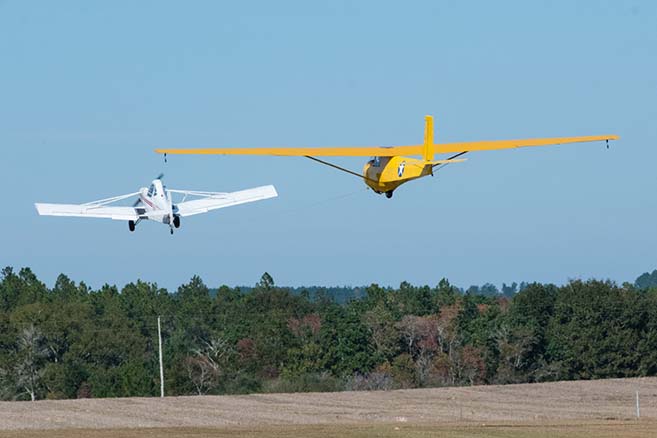Coastal glider enthusiasts transfer operations to local airport

By DON FLETCHER
News Staff Writer
Atmore residents have grown accustomed since January to a significant increase in air traffic that occurs nearly every Saturday in the sky over Atmore Municipal Airport. It appears the situation will remain about the same for some time, now that a group of Gulf Coast sailplane enthusiasts have moved their base of operations to the local airport.
John Bolyard, secretary for Coastal Soaring Association, said the group of glider pilots are finding the Atmore airport a better fit than their former base of operations in Elsanor, an unincorporated Baldwin County community just east of Robertsdale.
“The place where we were flying from is about 50 miles from where most of our members live, and it’s about 60 miles from Elsanor to Atmore,” said Bolyard, a trained glider pilot. “But [Atmore’s] environment is so much better for gliders. As far as lift, it’s about 4,000 feet at Elsanor and about 5,000 feet here. That’s another 1,000 feet of altitude, so we can go a lot farther.”
He said a preponderance of civilian and military aircraft traffic near the coast creates problems for the sailplane pilots. There is also another problem there that doesn’t exist here.
“Another problem at Elsanor is the sea breezes,” he explained. “Those breezes destroy all the lift and change the air. Atmore is maybe 40 miles inland, so it’s way better up here. Plus, there are all the farm fields, in case a pilot is having a bad day and has to land before getting back to the airport.”
CSA’s two dozen or so members are a mixed bag of men and women with a love of aeronautics, ranging from those who have logged extensive time as professional pilots of powered aircraft to those who are learning the ropes.
Most of those in attendance on March 25 live in Pensacola, Niceville or other communities in northwestern Florida or southwestern Alabama.
That group includes Casey Horgan (a glider instructor and U.S. Air Force Academy graduate who now flies C-130 transports); Rus Howard (glider instructor who owns his own glider); Fred Rettig (retired, owns his own jet-sustainer glider, was the primary coordinator of the move to Atmore); Don Rabon (long-haul trucker and novice glider pilot); Kyle Hyde (glider pilot, in waiting pool for Navy flight training); Ryan Novack (student glider pilot, War Games athlete at Eglin AFB); Michael Fink (16-year-old glider pilot student), and Emmett Moran (ex-Navy & commercial airliner pilot, glider instructor).
Fink is one of Coastal Soaring’s youngest trainees, although the group also boasts a 13-year-old girl. Fink is accumulating flight time that can be used when he sits for his Federal Aviation Administration license as an airline pilot.
“It’s a cheaper way to build up hours if you find some good thermals,” said the teen, who made his 14th flight on March 25. “My eventual goal is to become an airline pilot, and these hours count toward that.”
Hyde, who is a few years older than Fink, said he is learning to teach other would-be pilots to handle the sailplanes. He pointed out that the “social flying club,” like most civic or professional associations, needs new blood to keep its organizational heart beating.
“This is a real nice place to do glider operations,” Hyde said. “I’m a tower flight instructor but not a sailplane instructor, and it’s a little different. I want to do that because it’s aging out. There are more guys who are getting older, and not enough young people coming into it.”
Bolyard noted that clear, blue skies are not exactly the ideal environment for the flying machines, which are towed by a power airplane about 1,500 feet before they clear the runway and start climbing into the clouds.
“We like disturbed air,” he said. “If it’s a clear, blue-sky day, with no breeze, that’s when you want to go up in a power plane, like a Cessna, and it’s nice. That doesn’t do any good for glider pilots. The disturbed air gives you more lift, so you can stay in the air longer.”
Bolyard, who piloted the tow plane and pulled the gliders into the air on March 25, pointed out that Coastal Soaring Association isn’t just about learning to fly the mini planes.
“We provide training all the way up through instructor,” he said. “So, you can learn to become a private pilot, flying gliders, then take additional training and start flying power planes.”
Asked if the group literally “soars with eagles,” Bolyard said it does. He added that it also soars with “hawks, ospreys and buzzards. When you fly over or under one of those, they immediately roll over and go into a nosedive.”
He also pointed out there are risks involved in the avocation.
“A lot of things happen by chance, so we try to minimize chance with knowledge,” he said. “A lot of stuff you learn the hard way, a lot of other things you learn from people.”
The overall distance from the homes of many members to the new operations site is a little taxing for some, but Bolyard said the overall quality of the experience has converted most of those.
“The people out of Pensacola have to make a long drive, and some of them are struggling with that,” said Bolyard. “Once they come up here, though, they see that it’s not so bad at all. Elsanor was easier for all of us, but the benefits are much better up here.”
